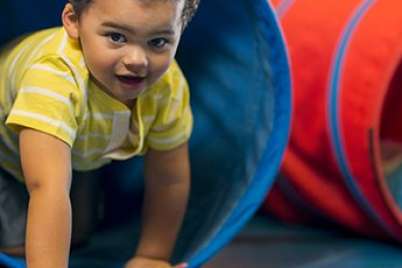
PE during a pandemic: How to help your students focus on building skills
Also in this series
PE on the field or pavement: Group games for open spaces PE on the playground: How to design an obstacle course PE on the playground: 4 active games that use school playground equipment PE in the forest: Group activities to develop movement skills in the woods1. Teach something in each PE lesson
This might sound like a no-brainer, but there have been lots of times where I’ve just released the hounds and let the kids enjoy the playground with no real direction or purpose. Setting the tone before you start, with a short review of a particular skill or concept, will give students something to think about as they play. It also gives us teachers something to focus on and build on throughout the year. It could be something simple like saying, “Today, we’re going to focus on balance.” Or show a video before heading outside to get the kids thinking about that particular skill and where they can practice it on the playground.Related read: Check out our collection of fundamental movement skills videos
2. Mix it up
Even the most exciting lessons and topics can be a bore if they drag on too long. Every second or third class, switch it up with a game or new skill to focus on. If you’re focusing on catching and throwing [PDF], for example, every few classes, throw in a playground game of Floor is Lava after a couple of sessions.3. Let them choose
Especially if you teach middle-grade or older students, they already have a lot of experience with PE games and activities. You can ask the kids to help choose a game or assign a pair of students to lead others through some exercises to show off some of the fundamental movement skills they’ve been practicing. They can follow the leaders through all the various places on the playground, fields, and open spaces to demonstrate specific skills and abilities.4. Give students meaningful feedback
Just like it’s important to provide students with feedback on their reading and writing, giving them useful and positive pointers when they’re exercising will help them build skill and confidence. Try to avoid comments such as “good job,” as these are often overused and can be too vague. Here are some example of constructive feedback:- “I can see how hard you are working.”
- “You were so nervous, and you did it!”
- “Can you show me where else you can stand on one leg?”
- “Okay. This time when you’re pushing up, can you wave to me?”
5. Keep it fun
Remember to smile, join in the fun, play some music, and just enjoy being active together.PE resources for teachers
- Active for Life: Elementary teachers toolkit with teaching resources and information such as checklists, printables, lesson plans, and articles
- Fundamental movement skills videos by KIDDO
- Ready-made printable lesson plans by Active for Life
- AfL’s cues for teaching FUNdamental movement skills [PDF]
- Creating a positive learning environment: Best practices for educators & leaders [PDF]
- ThePhysicalEducator offers great resources, articles, and professional development tools
- Ultimate Camp Resource has great non-equipment game ideas
- BOKS offers lots of free resources such as monthly fitness calendars, recess activity cards, lessons plans for physical distancing, and their Winter Fun Pack
Ideas for brain and movement breaks
- How to use a fortune teller with AfL’s printable fortune teller [PDF]
- Looking for a boredom buster? Try these printable activity dice with printable dice by KIDDO [JPG] and AFL’s version [PDF]
- 10 active “brain break” ideas kids will love
- 10 Lego games to get kids moving
- 5 group games from memory lane to pass on to your kids
- 10 ways to get kids active at your schools
- Get active in your neighbourhood with Explore your 2.4
- 3 outdoor PE games to play during the pandemic
- 7 summer camp games to play while physical distancing
- StoryWalk inspires families to get outside and read
For kindergarten and Grade 1 teachers
- Active for Life: Early years educators toolkit with resources, handouts, information, and useful links
- The evidence is in: Physical literacy in childcare benefits children, parents, and ECEs with a 5-minute video, infographics, APPLE Seeds handbook and other free resources
Resources to support physical literacy at home
- 6 active games kids can play with a pair of socks with printable PDF
- A printable recipe for an active day (at home)
- A printable recipe for an active year
- A printable outline to help kids plan their own day
- 4 practical tips to keep kids warm and safe during winter play with “dressing kids for winter” printable [PDF]
- How to dress for the weather in every season with printable
- Books to inspire your child to get outside, try new activities, and discover how they love to move
- School’s cancelled—what now? Here are 200+ activities you can do with kids at home
- 10 tips to make sure kids dress warmly enough in winter
- A beginner’s guide to meditation for calming the mind and emotions
- 42 easy activities to keep kids busy while parents work at home
- Being active after school better than homework for academic performance, research suggests






A great compilation of tips. It’s a tough gig to teach P.E. when you’re not trained in it, so these are definitely important things to keep in mind! Lots of fantastic resources that I use as a P.E. specialist too.